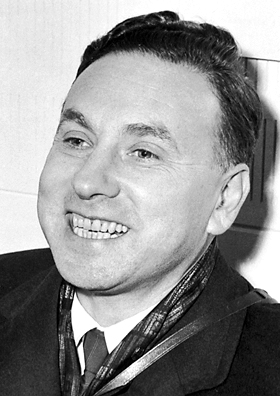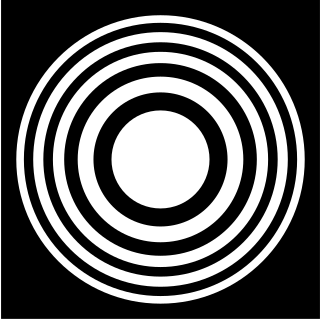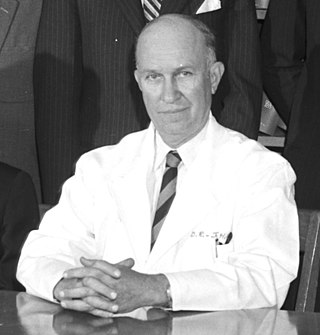Related Research Articles

Edward Teller was a Hungarian-American theoretical physicist who is known colloquially as "the father of the hydrogen bomb" and one of the authors of Teller–Ulam design. Teller was known for his scientific ability and his difficult interpersonal relations and volatile personality.

Robert Hofstadter was an American physicist. He was the joint winner of the 1961 Nobel Prize in Physics "for his pioneering studies of electron scattering in atomic nuclei and for his consequent discoveries concerning the structure of nucleons".

Arthur Holly Compton was an American physicist who won the Nobel Prize in Physics in 1927 for his 1923 discovery of the Compton effect, which demonstrated the particle nature of electromagnetic radiation. It was a sensational discovery at the time: the wave nature of light had been well-demonstrated, but the idea that light had both wave and particle properties was not easily accepted. He is also known for his leadership over the Metallurgical Laboratory at the University of Chicago during the Manhattan Project, and served as chancellor of Washington University in St. Louis from 1945 to 1953.

A zone plate is a device used to focus light or other things exhibiting wave character. Unlike lenses or curved mirrors, zone plates use diffraction instead of refraction or reflection. Based on analysis by French physicist Augustin-Jean Fresnel, they are sometimes called Fresnel zone plates in his honor. The zone plate's focusing ability is an extension of the Arago spot phenomenon caused by diffraction from an opaque disc.

An X-ray microscope uses electromagnetic radiation in the X-ray band to produce magnified images of objects. Since X-rays penetrate most objects, there is no need to specially prepare them for X-ray microscopy observations.

Maurice Goldhaber was an American physicist, who in 1957 established that neutrinos have negative helicity.

Samuel King Allison was an American physicist, most notable for his role in the Manhattan Project, for which he was awarded the Medal for Merit. He was director of the Metallurgical Laboratory from 1943 until 1944, and later worked at the Los Alamos Laboratory — where he "rode herd" on the final stages of the project as part of the "Cowpuncher Committee", and read the countdown for the detonation of the Trinity nuclear test. After the war, he returned to the University of Chicago to direct the Institute for Nuclear Studies and was involved in the "scientists' movement", lobbying for civilian control of nuclear weapons.
An X-ray microscope uses electromagnetic radiation in the soft X-ray band to produce images of very small objects.

John Hundale Lawrence was an American physicist and physician best known for pioneering the field of nuclear medicine.
William Allan Bardeen is an American theoretical physicist at Fermi National Accelerator Laboratory. He is the son of John Bardeen and Jane Maxwell Bardeen.
Myron Lindsay (Bud) Good was an American physicist, a professor of physics at the University of Wisconsin–Madison and Stony Brook University.
David Sayre was an American scientist, credited with the early development of direct methods for protein crystallography and of diffraction microscopy. While working at IBM he was part of the initial team of ten programmers who created FORTRAN, and later suggested the use of electron beam lithography for the fabrication of X-ray Fresnel zone plates.
William Houlder Zachariasen, more often known as W. H. Zachariasen, was a Norwegian-American physicist, specializing in X-ray crystallography and famous for his work on the structure of glass.
Paul Dutton Grannis is an American physicist.

Glennys Reynolds Farrar is a professor of physics at New York University who specializes in particle physics, cosmology and the study of dark matter. She has made several significant contributions to the fields of hadron and dark matter phenomenology, helping to develop the working "Standard Cosmological Model". Farrar is a figure in developing many modern particle-search techniques, achieving numerous recognitions including as the Guggenheim Fellowship for Natural Sciences and Sloan Fellowship. She holds a faculty position at New York University (NYU), where she has been since 1998.
Günter Schmahl was a German physicist, professor at the University of Göttingen and a pioneer of X-ray microscopy.
Elaine DiMasi is an American physicist and a staff scientist at Lawrence Berkeley National Laboratory, where she is the project lead of the optical systems for the upgrade of the Advanced Light Source.
David Attwood is an American physicist and professor emeritus at the University of California, Berkeley, where he worked in the field of synchrotron radiation and free-electron lasers, developing X-ray microscopy techniques for research and for the industry. He is the author of a reference book on soft X-rays and extreme ultraviolet radiation.
Henry N. Chapman FRS is a British physicist and the founding director of the Center for Free-Electron Laser Science at the German Electron Synchrotron (DESY). He has made numerous contributions to the field of x-ray coherent diffraction imaging and is a pioneer of the diffraction before destruction technique that allows to analyze biological samples with intense, ultrafast x-ray light, such as Photosystem II, a key macromolecule in photosynthesis.
The International Conference on X-Ray Microscopy (XRM) is a biennial international conference on X-ray imaging. The scope includes a range of topics in X-ray imaging, both in the soft and hard X-ray spectrum. Imaging by synchrotron light sources is the dominant topic, but small scale laboratory imaging is also included in many talks and posters. A number of subtopics are covered, including but not limited to X-ray microtomography, Phase-contrast X-ray imaging, Ptychography, and X-ray optics. The conference is typically five days long and held in summer. The conference is organized by an international committee and a local host organization. This local host is in most cases a synchrotron facility or an institute closely connected to a synchrotron. The host of the conference is decided two conferences in advance with a majority vote by all conference attendees. For example, the 14th XRM (2018) was decided during the 12th XRM (2014).
References
- ↑ "Janos Kirz". Advanced Light Source, Lawrence Berkeley National Laboratory. Archived from the original on 4 March 2016. Retrieved 22 June 2022.
- ↑ "Symposium reviews Edward Teller's varied contributions to science".
- ↑ Hargittai, István (2006). Martians of Science: Five Physicists Who Changed the Twentieth Century. United Kingdom: Oxford University Press. p. 10. ISBN 9780199884414.
- ↑ "Sloan Research Fellows". Alfred P. Sloan Foundation. Retrieved 22 June 2022.
- ↑ "Janos Kirz". John Simon Guggenheim Memorial Foundation. Retrieved 22 June 2022.
- ↑ "APSUO Arthur H. Compton Award - Past Winners". APS, Argonne National Laboratory. Retrieved 22 June 2022.